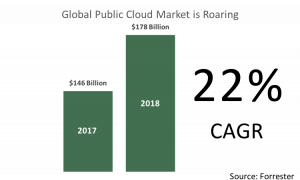The cloud is a hot space right now. How hot? Forrester predicts a global public cloud market of $178 billion by year’s end. That’s up from $146 billion last year. After 2018, Forrester pegs the compound annual growth rate at a whopping 22 percent.
The Undisputed Rulers of the Cloud: AWS and Azure
 The two biggest cloud platforms are Microsoft’s Azure and Amazon’s AWS, controlling a collective 46 percent of the market. Amazon dominates the market, in no small part because it was the first mover, with AWS dating back to 2002 and the platform we all now know debuting in 2006. Azure came along a bit later in 2008.
The two biggest cloud platforms are Microsoft’s Azure and Amazon’s AWS, controlling a collective 46 percent of the market. Amazon dominates the market, in no small part because it was the first mover, with AWS dating back to 2002 and the platform we all now know debuting in 2006. Azure came along a bit later in 2008.
There’s also some tension between Azure and AWS in terms of end user. AWS tends to be favored by engineering organizations, whereas Azure is preferred by IT.
AWS vs. Azure, Engineering vs. IT
The reasons for this are complicated, but one is that AWS has a very steep learning curve. It’s closer to what a developer would use than an administrator. This fits with how engineers think. They sign up for AWS, start writing code to customize out of the box AWS services for their own purposes and if they need to repeat that, it’s very easy to spin up. AWS simply offers a wider array of services engineers can begin tinkering with to make their own right away.
Azure, on the other hand, is a Microsoft product and is much more tied into other Microsoft products. That makes it great for automating Windows servers, provisioning and other tasks near and dear to the heart of IT.
Rethinking Conventional Wisdom on the Cloud
We believe the conventional wisdom with regard to Azure versus AWS is lacking. Each solution offers its own benefits and detriments. What’s more, the two can be leveraged together for a truly powerful cloud solution.
We started this series of posts to share more about Azure, AWS and how they can fit together in your organization. In our next post, we’ll discuss the status of AWS within engineering organizations.
Four Steps You Can Take
- Read how AWS & Azure can help turbocharge your manufacturing organization.
- Suggest a follow-up topic for Chris and Mike to discuss in their next podcast.
- Subscribe to our blog to stay informed on product development and engineering efficiency topics.
- Schedule a free consultation with a member of SPK and Associates today.







